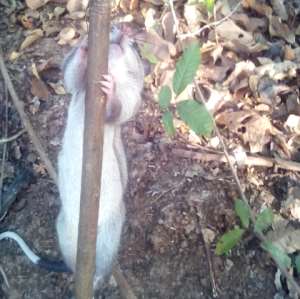
The City of New York in the United States of America (USA) has appointed a minister that will help eliminate rats infestation in the city. Miss Kathleen Corradi, a former school teacher, will be paid an annual salary of $170,000. It's so mouthwatering and enviable to be in her new position as Director of Rodent Mitigation. Her mandate is to lead 'wholesale slaughter' of the hated rodents, as charged by the City's Mayor, Eric Adams.
I wonder how the Apple City, amongst the richest in the world, is struggling so hard to do away with the rodents. They've tried many means, including poisoning and large traps over the years, but little results to show for.
Where I come from, a remotest village in Ghana's Bono Region, Goka, solution are in abundance to decolonise the unwanted scavenging rats.
All I will request is for the new Sheriff in town, the Rat Czar should use a tenth of her annual income to hire about a hundred boys from Goka in Ghana. They will not need any of the ubiquitous guns in the city. "Waya" is the only weapon needed to fight, tame and eradicate the pests.
Goka is a farming community. Both peasantry and commercial farming exist. Cashew nut is the major cash crop there.
Yams, cassava, maize and coco yam will be found on every one's farm. The farmers must protect their crops from predators like rats, grasscutters, birds and other pestering animals.
To achieve that, they set traps. They use a twisted cable locally known as “waya” (wire) to set the traps. The “waya” is in the likeness of the cable used for bicycle handbrake.
One yard costs less than Gh₵10 or $1 in Ghana. With every one yard of the “waya” twenty-one loops can be made to set 21 traps.
The traps come in many forms. There is “Anihafidie” (easily set trap on a stalk). Another is “Dadefidie” (using old and abandoned cutlass and waya/wire). Then the most crafty one is “Kuntunufidie”. If any rodent mistakenly steps in the loop, the stiffly dragging trap will hold the neck of the unfortunate animal until it suffocates to death.
The rats are a delicacy in Goka too, and they will serve as an important source of protein as well back home. They always live inside a hill. Only few burrow their holes in a non-hilly soil. You can set the trap at the mouth of the hole they move into and outside the hill. When strong boys with their dogs go into the bush to hunt for a rat to prepare a sumptuous meal, they can dig out the rat from the hole. They thus destroy the hill which serves as an outcrop for vegetables like pepper, garden eggs and tomatoes.
Also, mushrooms grow on the hill in its season. So digging the hill to smoke out the rat is not much encouraged. The hunters can even meet a bad catch. Some holes become a habitat for cobras. They kill the natives there, the rats that burrow the hole, and the snake will occupy it.
The foregone analyses clearly indicates that Goka in Ghana presents the perfect solution to the problem New York City is facing now.
Hire the boys, give them the tools, within one year, the results will be a blueprint for the world to emulate.
Since rats are widely consumed in Ghana and in many African countries, the Americans can think of devising means to preserve and market the catch here for profit. There will be ready customers for their product no doubt.
By Charles Yeboah (Sir Lord)
+233(0)249542111




 Tuesday’s downpour destroys ceiling of Circuit Court '8' in Accra
Tuesday’s downpour destroys ceiling of Circuit Court '8' in Accra
 SOEs shouldn't compromise on ethical standards, accountability – Akufo-Addo
SOEs shouldn't compromise on ethical standards, accountability – Akufo-Addo
 Father of 2-year-old boy attacked by dog appeals for financial support
Father of 2-year-old boy attacked by dog appeals for financial support
 Jubilee House National Security Operative allegedly swindles businessman over sa...
Jubilee House National Security Operative allegedly swindles businessman over sa...
 Nobody can order dumsor timetable except Energy Minister – Osafo-Maafo
Nobody can order dumsor timetable except Energy Minister – Osafo-Maafo
 Mahama wishes National Chief Imam as he clock 105 years today
Mahama wishes National Chief Imam as he clock 105 years today
 J.B.Danquah Adu’s murder trial: Case adjourned to April 29
J.B.Danquah Adu’s murder trial: Case adjourned to April 29
 High Court issues arrest warrant for former MASLOC Boss
High Court issues arrest warrant for former MASLOC Boss
 Align academic curriculum with industry needs — Stanbic Bank Ghana CEO advocates
Align academic curriculum with industry needs — Stanbic Bank Ghana CEO advocates
 Election 2024: We'll declare the results and let Ghanaians know we've won - Manh...
Election 2024: We'll declare the results and let Ghanaians know we've won - Manh...
